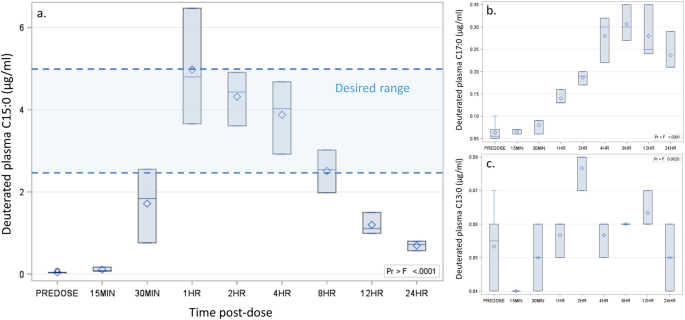Abstract
Pentadecanoic acid (C15:0) is an essential odd-chain saturated fatty acid with broad activities relevant to protecting cardiometabolic, immune, and liver health. C15:0 activates AMPK and inhibits mTOR, both of which are core components of the human longevity pathway. To assess the potential for C15:0 to enhance processes associated with longevity and healthspan, we used human cell-based molecular phenotyping assays to compare C15:0 with three longevity-enhancing candidates: acarbose, metformin, and rapamycin. C15:0 (n = 36 activities in 10 of 12 cell systems) and rapamycin (n = 32 activities in 12 of 12 systems) had the most clinically relevant, dose-dependent activities. At their optimal doses, C15:0 (17 µM) and rapamycin (9 µM) shared 24 activities across 10 cell systems, including anti-inflammatory (e.g., lowered MCP-1, TNFα, IL-10, IL-17A/F), antifibrotic, and anticancer activities, which are further supported by previously published in vitro and in vivo studies. Paired with prior demonstrated abilities for C15:0 to target longevity pathways, hallmarks of aging, aging rate biomarkers, and core components of type 2 diabetes, heart disease, cancer, and nonalcoholic fatty liver disease, our results support C15:0 as an essential nutrient with activities equivalent to, or surpassing, leading longevity-enhancing candidate compounds.
…
Conclusion
In summary, our studies and prior literature show that C15:0 and rapamycin, a leading healthspan and longevity-enhancing intervention candidate, share numerous clinically relevant activities, including anti-inflammatory, anticancer, antifibrotic, antimicrobial, and mTOR-inhibiting activities. Further, as an AMPK activator, C15:0 also showed multiple similarities to metformin, especially at specific doses. Above and beyond in vitro and in vivo studies, C15:0 has the added benefit over rapamycin and metformin of having its associations with health studied in global meta-analyses of large prospective cohort studies that have taken place over decades, most of which included healthy individuals; these studies consistently show that people with higher circulating C15:0 concentrations have a lower risk of aging-associated conditions. Given the voluminous supporting literature, we propose C15:0 as a natural, effective, and safe odd-chain saturated fatty acid with strong evidence that this essential nutrient supports healthy aging and longevity in humans, with cell-based activities that are as good as, or better than, leading longevity-enhancing prescription therapeutics. Given population wide declining C15:0 levels, there is a need to evaluate the potential effects of nutritional C15:0 deficiencies on our healthspan and longevity.
Thoughts
Pretty extraordinary if this holds up.
Questions
- Does anyone have an idea on C15:0 dosing for humans?
- Delivery method
- If oral, does it require enteric coating or encapsulation?
- Could one “stack” it with rapamycin or possible alternate week to week?
Even more from Nature…
Efficacy of dietary odd-chain saturated fatty acid pentadecanoic acid parallels broad associated health benefits in humans: could it be essential?
2020
https://www.nature.com/articles/s41598-020-64960-y
Abstract
Dietary odd-chain saturated fatty acids (OCFAs) are present in trace levels in dairy fat and some fish and plants. Higher circulating concentrations of OCFAs, pentadecanoic acid (C15:0) and heptadecanoic acid (C17:0), are associated with lower risks of cardiometabolic diseases, and higher dietary intake of OCFAs is associated with lower mortality. Population-wide circulating OCFA levels, however, have been declining over recent years. Here, we show C15:0 as an active dietary fatty acid that attenuates inflammation, anemia, dyslipidemia, and fibrosis in vivo , potentially by binding to key metabolic regulators and repairing mitochondrial function. This is the first demonstration of C15:0’s direct role in attenuating multiple comorbidities using relevant physiological mechanisms at established circulating concentrations. Pairing our findings with evidence that (1) C15:0 is not readily made endogenously, (2) lower C15:0 dietary intake and blood concentrations are associated with higher mortality and a poorer physiological state, and (3) C15:0 has demonstrated activities and efficacy that parallel associated health benefits in humans, we propose C15:0 as a potential essential fatty acid. Further studies are needed to evaluate the potential impact of decades of reduced intake of OCFA-containing foods as contributors to C15:0 deficiencies and susceptibilities to chronic disease.

